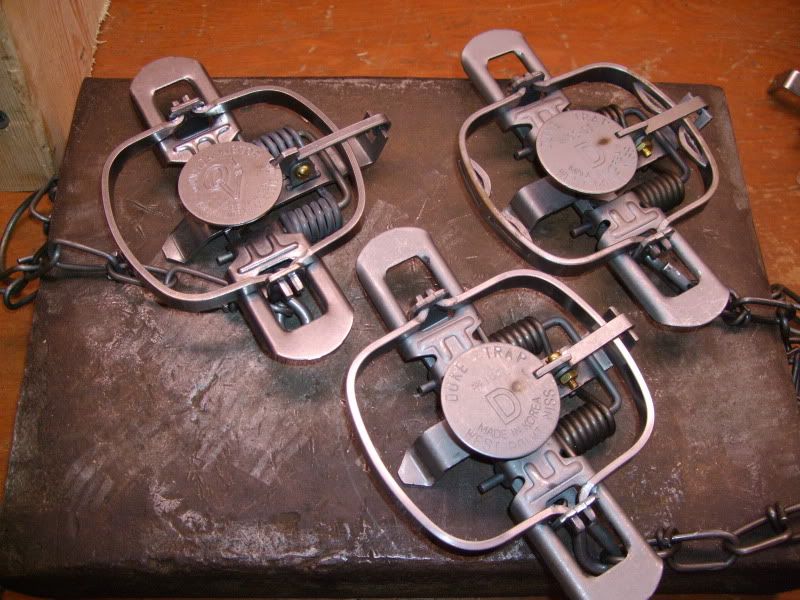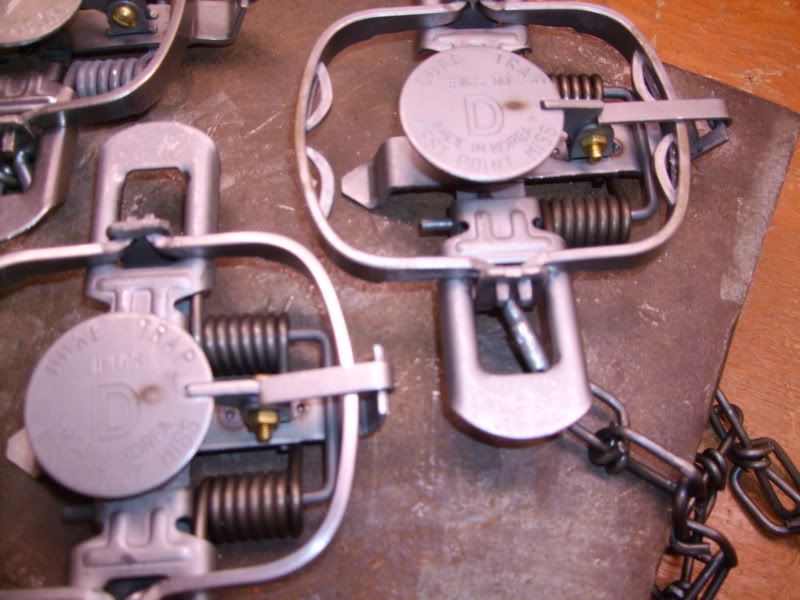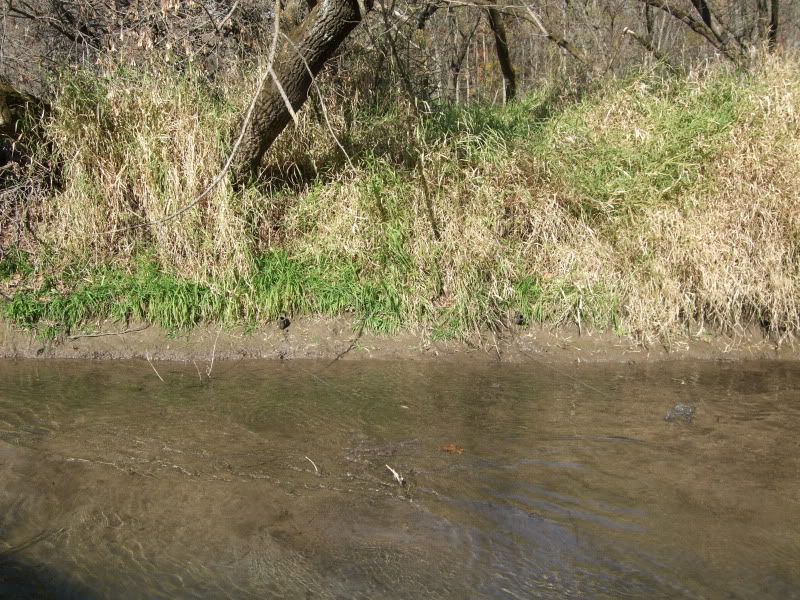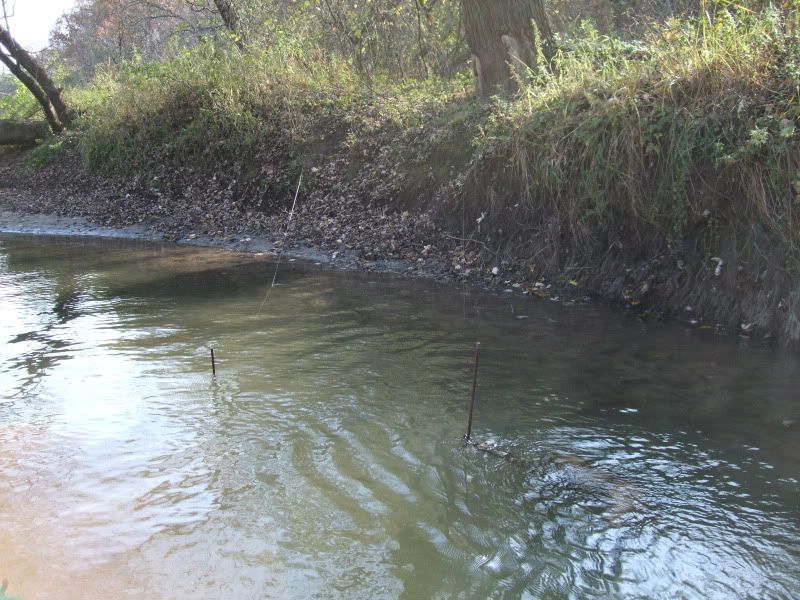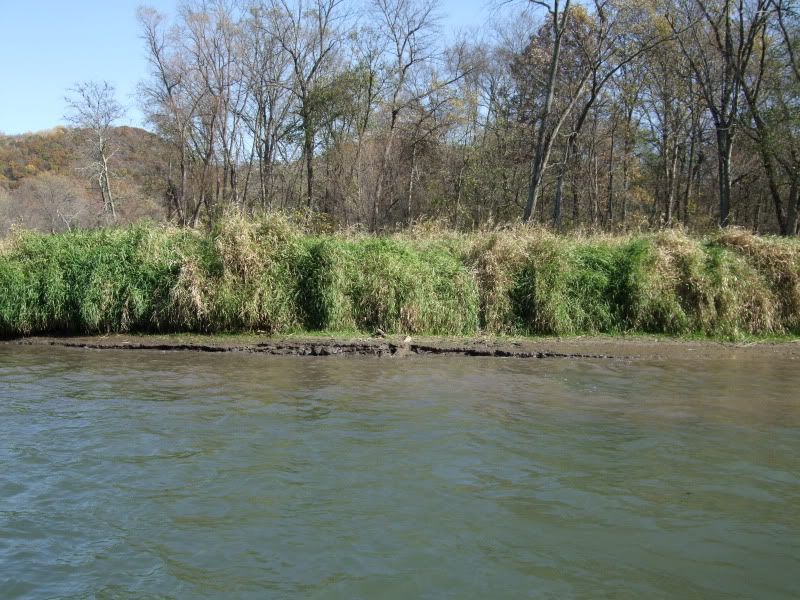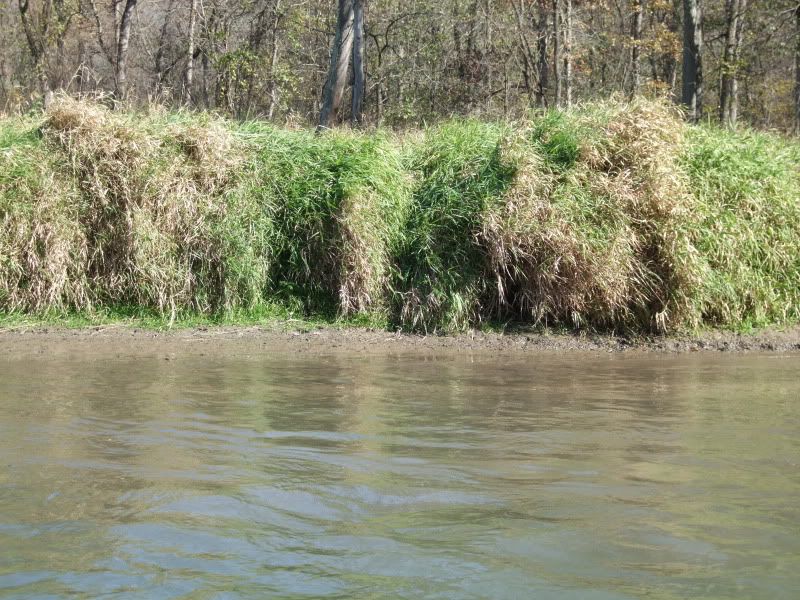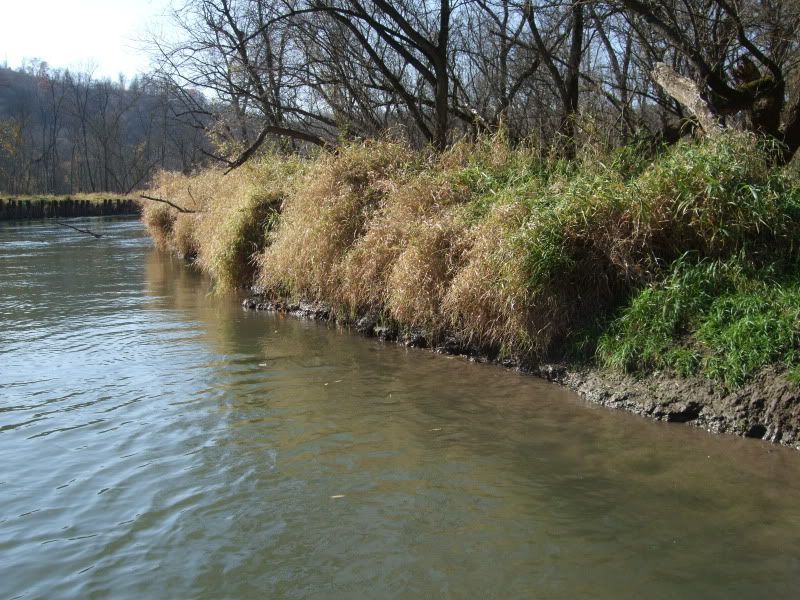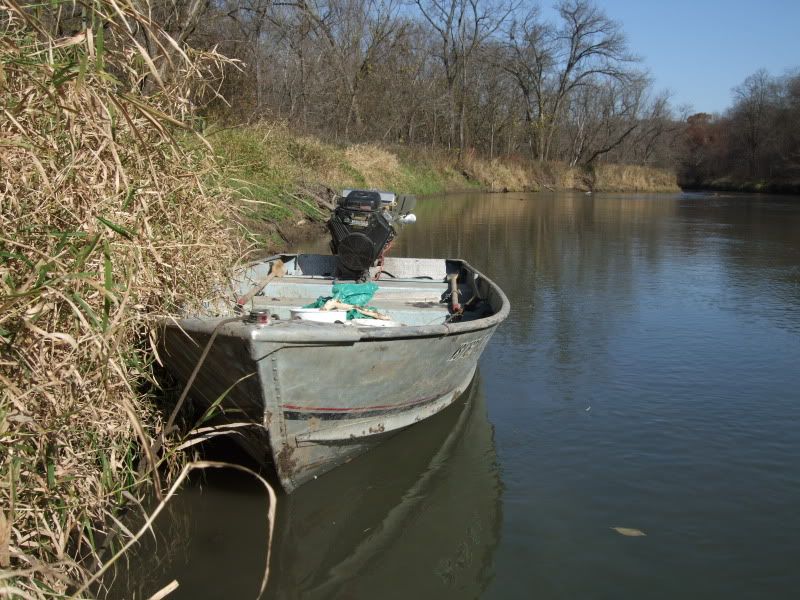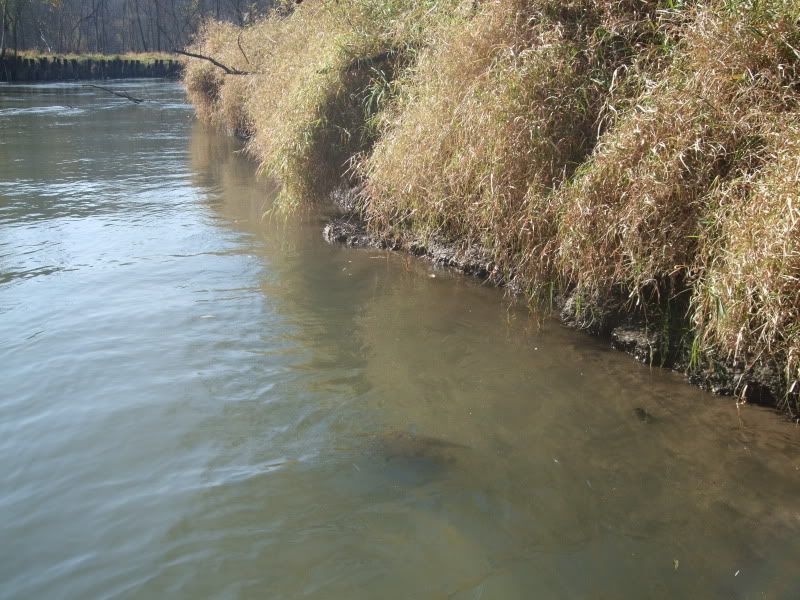Post by mustelameister on Feb 7, 2012 21:56:24 GMT -6
Disclaimer: Attempting to duplicate any of the sets described herein may cause you to rethink using large traps for 'coon, mink and 'rats. 
Factoids:
1) In this area . . . a drowned 'rat in 5" of water will not be in one piece or probably even there two or three days later if caught the first night.
Rationale: There are a host of predators, in this area, that are just waiting to snack on your catch, muskrats especially. I've got to get my 'rats underwater down here, on the bottom, away from the eyes of mink, otter, owls, hawks, eagles, 'coon, and probably coyote. A pocket or pipe set for me is a set for 'coon, mink and 'rats. I want any of those 3 critters to be down on the bottom and out of sight.
2) One does not need a large or heavy trap to drown a critter if the trap is hooked up to an efficient drowner system.
3) A smaller trap is more likely to slide down a drowner system than is a larger, heavier trap.
Rationale: A smaller trap can be moved easier by a caught critter than if it was caught in a larger, heavier trap, in most situations. Of course the ideal situation is a dropoff adjacent to the trap where the critter simply struggles and drops "over the cliff".
But what if that set has a couple feet of shallow water before entering deeper water? There's my problem.
Let's take a look at a pic that I posted earlier. Here's a typical pocket set for me. Small diameter pocket, bait speared in the back, chimney hole made with rerod stake maybe 10" back with shellfish/salmon oil squirted down into it, and #11 DJ directly in front with dogged jaw facing in. Loose jaw is guarded with pencil-diameter stick on the outside unless extremely cold conditions are coming then removed because of ice buildup. Standard set for me. The pan becomes the stepping stone for a 'coon. Mink and 'rats simply funnel over the trap.
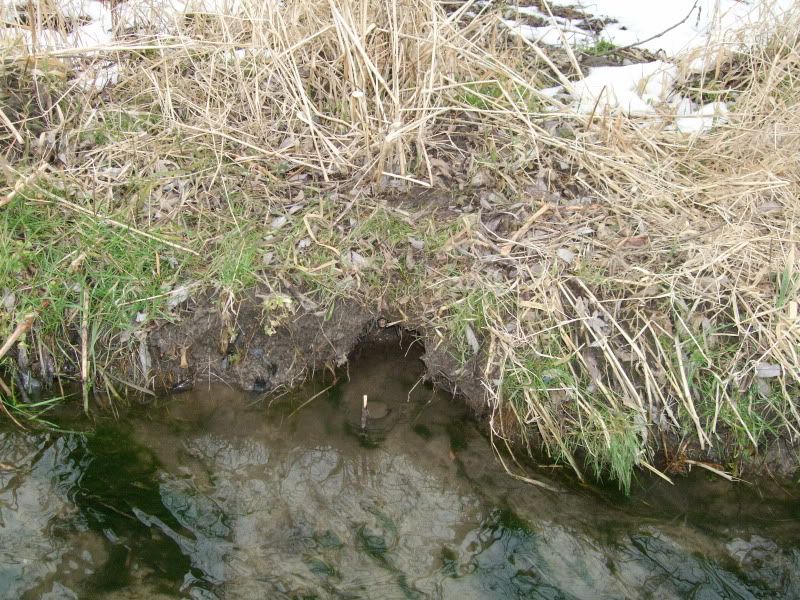
Checked the set this afternoon and the trap is gone. Notice the guard stick for the loose jaw is still there. The set itself is undisturbed. That's part of the beauty of a drowning set.
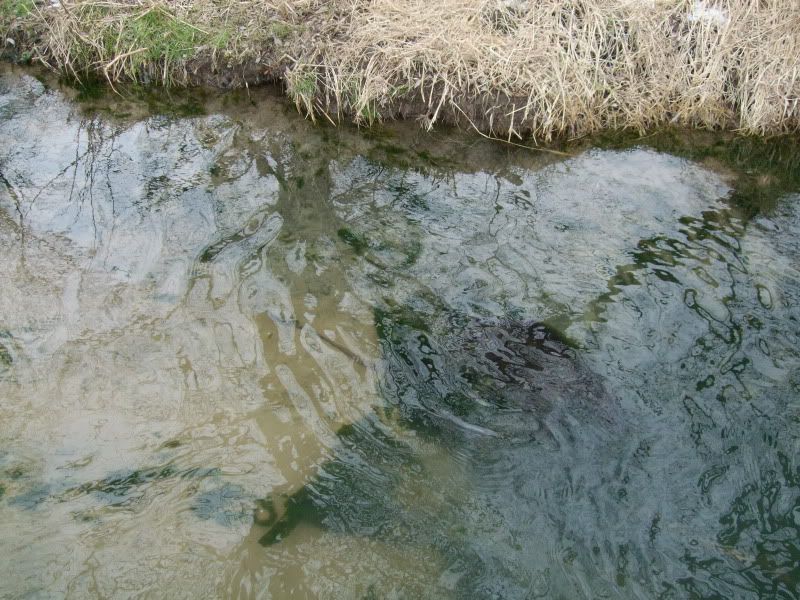
February 7th 'coon in a #11 DJ. Note the nice pad catch. Note it's locked onto the front left foot. I believe most 'coon work a stream of this nature wading upstream. Approaching the small pocket, they'll plant their front left foot (on this bank) directly in front to reach or step in with their right front foot. Same for a PVC pipe that is horizontal and just above the water's surface. Small target area allows for small trap. Easily carried away.
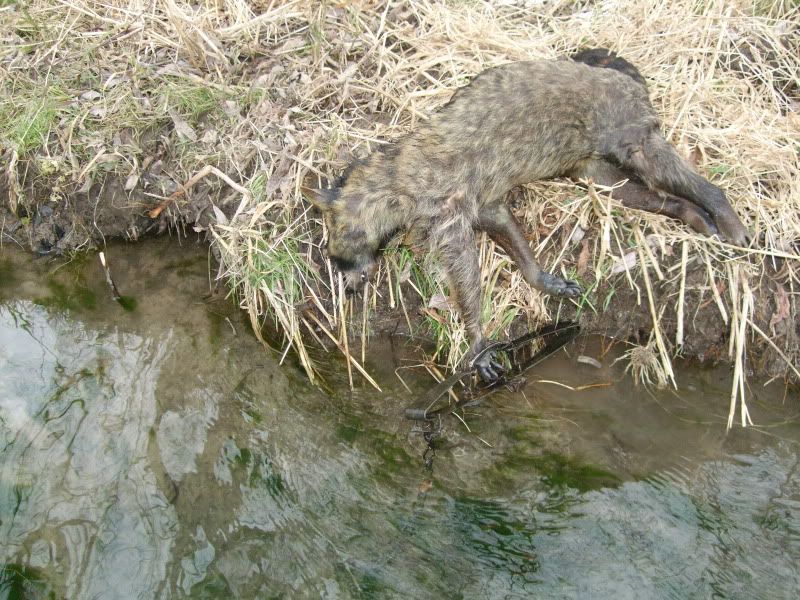
I ran drowner rods on the Baraboo River for several years and grew to appreciate them. Deep water was almost always adjacent to the trap and any trap worked just fine. Well, they don't work all that well in this sandy river and adjacent creeks and marshes. I tried to incorporate them last year, but went to the vertical 5' rerod post on the terminal end with the cable and that's what's working for me. Try sticking your 18" T-bar into sand and see where that gets you when it comes time to check.
The GAC can be used in any length. Pockets, pails or packbaskets with different lengths coiled up are easy to utilize at the set location. That's what works for me now and I don't see myself going back to rods.
Now I will admit the #11 can be trying for 'rats to carry away in shallow water for a ways before drowning. So I'm switching from longsprings to coilsprings next year in sets where I'm fairly certain the target critter is the muskrat or mink. If a 'coon does get into the set, that's fine, but this is where I'm thinking 'rat.
A comparison of a #11 to a #1 coilspring:

So this winter I ordered up all the #1 coilsprings I could find offered and made my own comparisons:
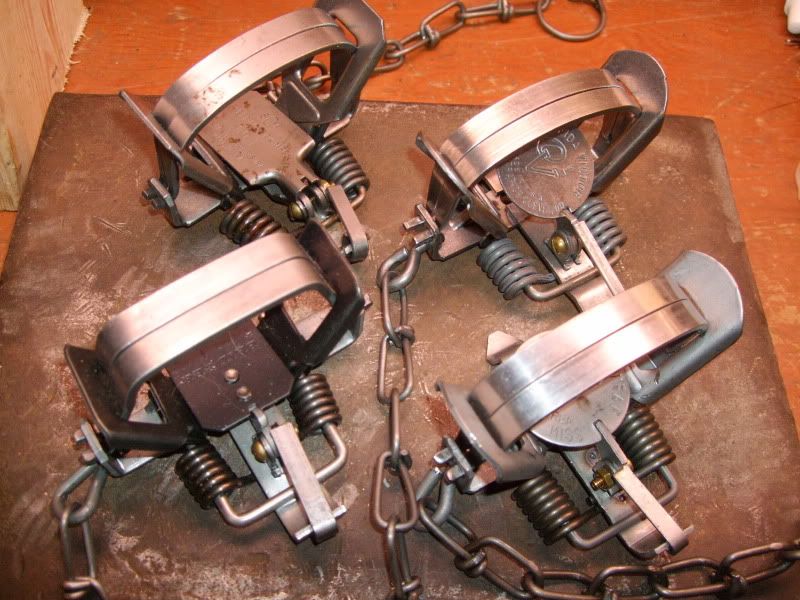
First one I ruled out right away was the Bridger in the lower left-hand corner. Spring levers are way too short on top. A real pain, for me anyway, when trying to set. Springs seemed a little weak compared to the others, IMO.
Next ruled out was the Sleepy Creek, upper left-hand corner. I don't care for the dog/pan system and they're pricey.
That leaves the Victor and the Duke. Very comparable traps. Spring strength goes to Duke, IMO, in fact, if you count coils looks to me like the Duke has one more coil. The dog is wider on the Duke, though I'm not sure that makes much difference. When it comes down to buying these traps, one can buy more Dukes than Victors, so . . . .
The Duke #1 coilspring will be my pipe and pocket trap for next season when I'm fairly certain 'rats are probable catches. If I'm fairly certain it's just 'coon that will be checking these sets out I'll be going with the #11. I do go with the spendier Newhouse #11 DJ over the Duke.
Now back to rods vs cable for a moment.
How would I hook that DP on the left up to a rod? That's one sweet 'coon trail coming down behind that tree and I want that DP right in its face. Cable works just fine here.
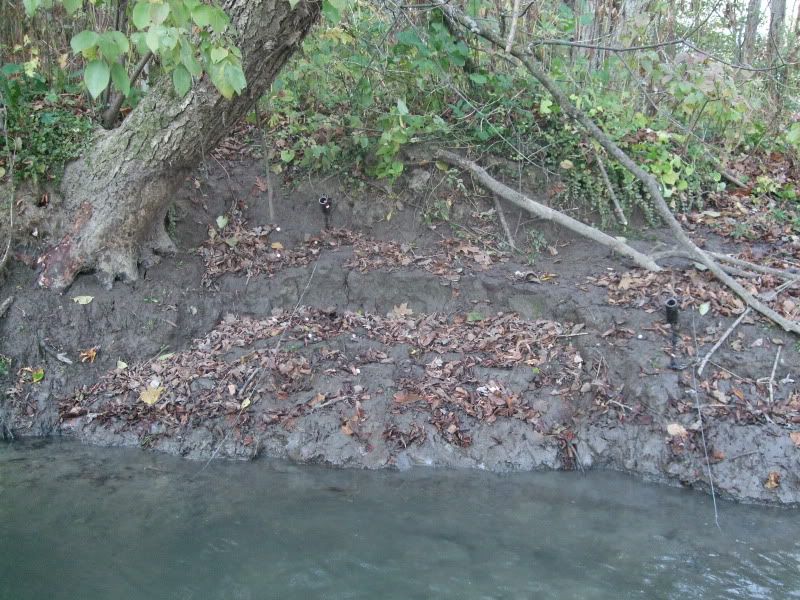
I shared the terminal vertical 5-foot rerod system 'cause it solved a lot problems for me and is easy to apply especially out of a boat. Thought maybe a few fellas might find it applicable on their waterline. It isn't a drowning rod and maybe it was the wrong thread to post it on.
Small traps do indeed have smaller catch areas. But if you know where that foot is going to land, you can almost guarantee yourself a catch if you know what you're doing.
And that's all. I'm going to give these #1 coilsprings a whiz next season and maybe I'll sell 'em all a year from now. We'll see. Anyway, for what it's worth.
Factoids:
1) In this area . . . a drowned 'rat in 5" of water will not be in one piece or probably even there two or three days later if caught the first night.
Rationale: There are a host of predators, in this area, that are just waiting to snack on your catch, muskrats especially. I've got to get my 'rats underwater down here, on the bottom, away from the eyes of mink, otter, owls, hawks, eagles, 'coon, and probably coyote. A pocket or pipe set for me is a set for 'coon, mink and 'rats. I want any of those 3 critters to be down on the bottom and out of sight.
2) One does not need a large or heavy trap to drown a critter if the trap is hooked up to an efficient drowner system.
3) A smaller trap is more likely to slide down a drowner system than is a larger, heavier trap.
Rationale: A smaller trap can be moved easier by a caught critter than if it was caught in a larger, heavier trap, in most situations. Of course the ideal situation is a dropoff adjacent to the trap where the critter simply struggles and drops "over the cliff".
But what if that set has a couple feet of shallow water before entering deeper water? There's my problem.
Let's take a look at a pic that I posted earlier. Here's a typical pocket set for me. Small diameter pocket, bait speared in the back, chimney hole made with rerod stake maybe 10" back with shellfish/salmon oil squirted down into it, and #11 DJ directly in front with dogged jaw facing in. Loose jaw is guarded with pencil-diameter stick on the outside unless extremely cold conditions are coming then removed because of ice buildup. Standard set for me. The pan becomes the stepping stone for a 'coon. Mink and 'rats simply funnel over the trap.

Checked the set this afternoon and the trap is gone. Notice the guard stick for the loose jaw is still there. The set itself is undisturbed. That's part of the beauty of a drowning set.

February 7th 'coon in a #11 DJ. Note the nice pad catch. Note it's locked onto the front left foot. I believe most 'coon work a stream of this nature wading upstream. Approaching the small pocket, they'll plant their front left foot (on this bank) directly in front to reach or step in with their right front foot. Same for a PVC pipe that is horizontal and just above the water's surface. Small target area allows for small trap. Easily carried away.

I ran drowner rods on the Baraboo River for several years and grew to appreciate them. Deep water was almost always adjacent to the trap and any trap worked just fine. Well, they don't work all that well in this sandy river and adjacent creeks and marshes. I tried to incorporate them last year, but went to the vertical 5' rerod post on the terminal end with the cable and that's what's working for me. Try sticking your 18" T-bar into sand and see where that gets you when it comes time to check.
The GAC can be used in any length. Pockets, pails or packbaskets with different lengths coiled up are easy to utilize at the set location. That's what works for me now and I don't see myself going back to rods.
Now I will admit the #11 can be trying for 'rats to carry away in shallow water for a ways before drowning. So I'm switching from longsprings to coilsprings next year in sets where I'm fairly certain the target critter is the muskrat or mink. If a 'coon does get into the set, that's fine, but this is where I'm thinking 'rat.
A comparison of a #11 to a #1 coilspring:

So this winter I ordered up all the #1 coilsprings I could find offered and made my own comparisons:

First one I ruled out right away was the Bridger in the lower left-hand corner. Spring levers are way too short on top. A real pain, for me anyway, when trying to set. Springs seemed a little weak compared to the others, IMO.
Next ruled out was the Sleepy Creek, upper left-hand corner. I don't care for the dog/pan system and they're pricey.
That leaves the Victor and the Duke. Very comparable traps. Spring strength goes to Duke, IMO, in fact, if you count coils looks to me like the Duke has one more coil. The dog is wider on the Duke, though I'm not sure that makes much difference. When it comes down to buying these traps, one can buy more Dukes than Victors, so . . . .
The Duke #1 coilspring will be my pipe and pocket trap for next season when I'm fairly certain 'rats are probable catches. If I'm fairly certain it's just 'coon that will be checking these sets out I'll be going with the #11. I do go with the spendier Newhouse #11 DJ over the Duke.
Now back to rods vs cable for a moment.
How would I hook that DP on the left up to a rod? That's one sweet 'coon trail coming down behind that tree and I want that DP right in its face. Cable works just fine here.

I shared the terminal vertical 5-foot rerod system 'cause it solved a lot problems for me and is easy to apply especially out of a boat. Thought maybe a few fellas might find it applicable on their waterline. It isn't a drowning rod and maybe it was the wrong thread to post it on.
Small traps do indeed have smaller catch areas. But if you know where that foot is going to land, you can almost guarantee yourself a catch if you know what you're doing.
And that's all. I'm going to give these #1 coilsprings a whiz next season and maybe I'll sell 'em all a year from now. We'll see. Anyway, for what it's worth.





